« May 2013 |
Main
| July 2013 »
 June 27, 2013 | Best of JM: Why Closed Fingerings again?
June 27, 2013 | Best of JM: Why Closed Fingerings again?
Enjoy the popular archive material below.
From June 11, 2009 | Why Closed Fingerings again?
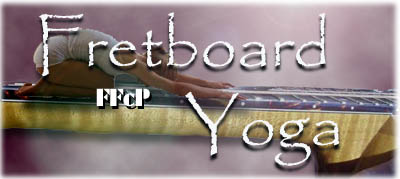
For the folk/bluegrass musician, the notion of closing up fingerings and forsaking the open strings seems very much counterintuitive. The majority of the repertoire is based on open string keys, songs played within the relative comfort and safety of of G, D, or A. In those keys, you not only have the root of the key in an open string, you have that important 5th (D, A, E) to ring out in the Tonic chord and Dominant. You can strum and ring all you want, sometimes with a forgivable dispensation of missed strings. So why worry about closing things up and torturing the pinky with that 7th fret stretch? Let's look at four reasons:
Horn Keys. The church hymnal strikes fear in the heart of many a novice mandolinist. Keys of F, Bb, Db are not uncommon as the literature is written for voice register. Same thing with Broadway tunes and you have an entire body of jazz written for the sax and trumpet. Understand if an Eb alto sax is trying to play in the key of A with the rest of the band, he/she has to think in F#, which explains why so much "horn" music is in the keys of Eb (C on the a/sax) and Bb. Friendly to the mandolin? Definitely not if you're expecting to use much in the way of open strings, especially on those critical notes of tonic and dominant.
Transposability. So you learn the FFcP, study and master all kinds of patterns that are now movable. So what do you gain? THE WORLD! You can move intuitively across strings and frets, and now you're not thinking note names, you're thinking scale degrees and patterns. Some might argue you aren't "thinking" at all any more--just "doing." In other words, you improvise through an intuition based on sound and feel. You "sing" the music through your fingers. We've enjoyed the feedback of many who have achieved this sate of FFcP Zen. "The notes are just coming to my fingers from nowhere!"
Range extension. This goes along with the transposablity; you now aren't limited to the lower frets of the mandolin but are free to securely wander in the upper altitudes of the fretboard. Once you adapt to the closer spacing of the 9th through 15th frets, you are practically handed a new instrument. This is a cool way to get around.
Tonal variety. Yes, the resonant zing from an open string is natural sonic beauty. There is also an articulation consistency when a succession of notes is completely closed in fingers. Play the open D on your mandolin and follow up with a 7th fret (G string) D; you'll hear a tonal difference. One isn't necessarily better or worse, just more consistent with the other notes you're playing in a sequence. Also, if you're really in control, you can get a subtle vibrato on a long sustained note. This is why orchestral musicians actually prefer closed over open fingerings.
We recently took a step back and submitted in our June MandolinSessions column, a review on what FFcP is all about. If you are new to this, or simply want to understand the overview mechanics of the Four Finger Closed Position, take the time to read this.
Read Jazz Mandology "Closed Fingerings"
Further:
The Importance of Pinky
Doublestops and Barre Chords
The Ab Position
Fear of Flying
Leading Off Third Base; The benefits of third position fingering
Posted by Ted at 8:15 AM
 June 20, 2013 | Equal temperament and mandolin
June 20, 2013 | Equal temperament and mandolin
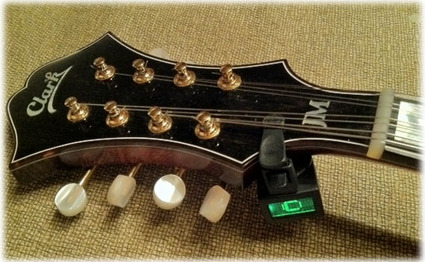
It's been said that a mandolinist spends half the time tuning, the other half playing out of tune. If you do a google search, you'll find this joke is attributed to harpists, classical guitarists, and a myriad of other instrumentalists. If you want to get technical, this is more apparent (and literal) when you study the notion of equal temperament tuning.
We don't want to get to technical about it except to say the nature of pitch is relative to the fundamental of the root of a scale, and when it's divided out in 12 steps, it's not consistent from key to key. The 5th is close (but not perfect) and the 3rd can be way off by the time you travel around the circle of keys. An innovation in the 18th century set up a kind of compromise tuning known as "equal temperaments" but even in the 19th century many classical composers wrote piano music for "Just" and other variations of the temperament. If there wasn't a lot of modulation, it wasn't that much of an issue. Today's music (especially atonal or 12-tone) requires a compromise temperament, and it's the same with a fretted instrument like the mandolin.
It's really not an issue for most, but if you're playing with a fiddler or a wind instrument, chances are they are incrementally adjusting their 3rds and 5ths in long tones and this might explain the perception of a guitar or mandolin being out of tune despite exhaustive efforts with an electronic tuner before and during a performance.
The difference is quite a bit more obvious in a harmonica, and we stumbled on a website where this is demonstrated aurally. You can really hear it in the chords.
Visit site:
Audio Examples of Just Intonation and Equal Temperament Applied to the Harmonica
Read more about Well vs. Equal Temperament
Explanation of other temperaments: The 12 Golden notes is all it takes...
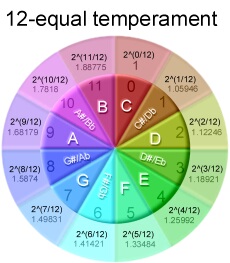
Posted by Ted at 2:20 PM
 June 13, 2013 | 5-string Mandolin Chord Sets: Major 'ii7 V7 I"
June 13, 2013 | 5-string Mandolin Chord Sets: Major 'ii7 V7 I"
We're back to our series on 5-string chords. We remind you since we're focusing on the 3-note voicings in the lower three strings, these still work great for the mandola, tenor banjo or CGDA tenor guitar tuning. We gave you a PDF of chord pairs, the 'ii7b5 V7' combination for minor keys, and last time around we want extended into a full cadence, the 'ii7b5 V7 I' progression.
The minor keys were a little more of a challenge for many, that awkward ii7b5 chord a bit foreign to the folk ear. This time we'll finish the series with a plain major progression, the 'ii7 V7 I,' perhaps the most important harmonic "sentence" in western European music, let alone jazz.
We'll give these to you in four different grips, your chore is to transpose these to all 12 keys. Simple to expand out, drop down a fret or two, move up a fret or two, and you instantly have 1/3 of the keys covered.
Here's the first:
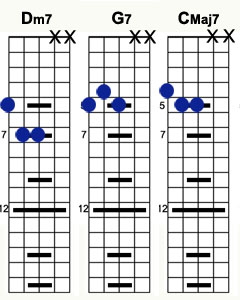
Again, move this down two frets, you have the blocks for Bb (Cm7 F7 BbMaj7), up two frets for D (Em7 A7 DMaj7). Frets in between give you the less chromatically friendly B and Db Major.
Next:
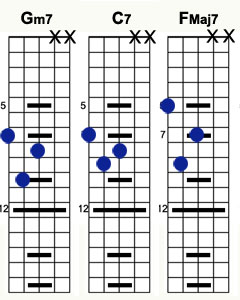
Down two frets for Eb (Fm7 Bb7 EbMaj7), up two for G (Am7 D7 GMaj7).
Mix up the next two similarly for further variations and you've pretty thoroughly covered all possibilities:

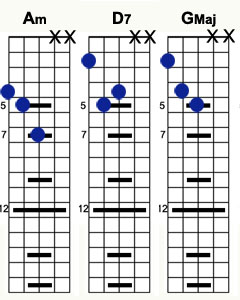
Here's a handy PDF for your library to download:
Print PDF:  5-string Mandolin Chord Major 'ii7 V7 I' 5-string Mandolin Chord Major 'ii7 V7 I'

Be sure to go back an review the minor variations and the accompanying free PDFs of these from our archive! Download the chord template and start documenting a library of your own.
Free 5-string chord template PDF
5-string Mandolin Chord Sets: Minor 'ii7b5 V7 i"
5-string chord pairs: 'm7b5 V7'
Posted by Ted at 7:59 AM
 June 6, 2013 | Best of JM: 10,000 hours? Discipline... in moderation.
June 6, 2013 | Best of JM: 10,000 hours? Discipline... in moderation.
Enjoy the popular archive material below.
From May 21, 2009 | 10,000 hours? Discipline... in moderation.
Best selling author Malcolm Gladwell author of "The Tipping Point" and "Blink," released a new book last year, "Outliers: The Story of Success." Gladwell has some fascinating theories on what it takes to become an "Outlier" the high achiever, the best, the brightest, and the most successful of people. One of them is his take on the 10,000 hours phenomenon which is especially relevant to the topic of prodigies.
He explains that in the early 1990's psychologist K. Anders Ericsson and two colleagues conducted an experiment at Berlin's "Academy of Music," where the school's violinists were divided into three groups:
1.) Stars
2.) Good performers
3.) Those who were unlikely to ever play professionally and would probably become music teachers.
These were all asked the question: "Over the course of the years, ever since you picked up a violin, how many hours have you practiced."
"All of the violinists had started playing at around age five, and they all played about two or three hours a week during the first few years. However, around the age of eight, an important difference began to emerge in the amount of hours they each practiced. By age 20, the stars in the group had all totaled 10,000 hours of practice over the course of their lives; the "good" students had totaled 8,000 hours; and the future music teachers just over 4,000 hours.
What the research suggested was that once you have enough talent to get into a top music school, the thing that distinguishes one performer from another is how hard he or she works. In addition, other studies have also shown that excellence at a complex task requires a minimum level of practice, and experts have settled on 10,000 hours as the magic number for true expertise. This is true even of people we think of as prodigies, such as Mozart."
Neurologist Daniel Levitin reports, "In study after study, of composers, basketball players, fiction writers, ice-skaters, concert pianists, chess players, master criminals, this number comes up again and again. Ten thousand hours is equivalent to roughly three hours a day, or 20 hours a week, of practice over 10 years... No one has yet found a case in which true world-class expertise was accomplished in less time. It seems that it takes the brain this long to assimilate all that it needs to know to achieve true mastery."
So where does that leave you? Don't have 10 years to practice three hours a day? Most of us in the bifocal crowd certainly don't have, unless independently wealthy. We just have to accept the fact that we aren't likely to become the next Chris Thile or Mike Marshall. That doesn't mean we can't have fun or even get better, but we need to be realistic in our outcome.
We may never be a Tiger Woods, but we can still enjoy golf. A little discipline in moderation can make us better through practice and coaching. We'll probably enjoy ourselves playing the sport as we work to get more efficient and effective. We can't however, afford to be frustrated with unrealistic goals. Balance finger-building exercises with literature, jamming, and listening, and our mandolinning will get reasonably better.
Practice scales musically. Adding some dynamics to the most remedial patterns can make them aesthetically more pleasing. After all, if you can't play scales musically, it's not likely you can play music musically! You likely don't have the time for three ours a day the next ten years; maybe even 30 minutes is a struggle. Still, make the most of practice time and enjoy yourself along the way.
Gladwell has some other interesting observations about achievers. It's a good read; if you're a regular reader here at JazzMando, you're probably the type that would enjoy this book.
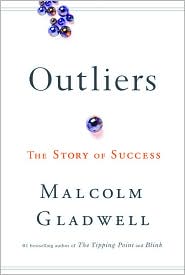
Outliers: The Story of Success by Malcolm Gladwell
Further:
Why Play?
Practice Regime; A Balanced Diet
The Joy of Mandolinning
Are you improving?
January Fitness
Posted by Ted at 5:48 AM

Disclaimer: In the 'Information Age' of the 21st Century,
any fool with a computer, a modem, and an idea can
become a self-professed 'expert." This site does not
come equipped with 'discernment.'
|



